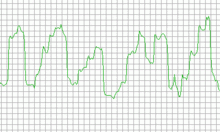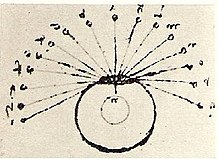created 2025-04-10, & modified, =this.modified
rel: Musicality and Frets Neurolinguistics
In the late 19th century, ophthalmologist Louis Emile Javal reported that eyes do not move continuously across a line of text, but make short, rapid eye movements saccades intermingled with short fixations. This observation was done in the in the absence of eye tracking technology.
The eye as seen from Leonardo da Vinci, has a central line and everything that reaches the eye through this central line can be seen distinctly.
He wrote “The function of the human eye, … was described by a large number of authors in a certain way. But I found it to be completely different.”*
Eye Tracking
Early ET efforts involved placing instruments in contact with the eye, or eyelid.
In 1883, Lamare was the first to use a mechanical connection, by placing a blunt needle on the participant’s upper eyelid. The needle picked up the sound produced by each saccade and transmitted it as a faint clicking to the experimenter’s ear through an amplifying membrane and a rubber tube. The rationale behind this device was that saccades are easier to perceive and register aurally than visually.
In 1889, Edmund B. Delabarre invented a system of recording eye movement directly onto a rotating drum by means of a stylus with a direct mechanical connection to the cornea.
Modern ET
Four major cognitive systems are involved in eye movement during reading
- language processing, attention, vision, and oculomotor control. ETs bounce near infrared light off the interior of the eyeball, and monitor the reflection on the eye to determine gaze location.
Saccades
 Skilled readers move their eyes during reading on the average of every quarter of a second. During the time that the eye is fixated, new information is brought into the processing system
Skilled readers move their eyes during reading on the average of every quarter of a second. During the time that the eye is fixated, new information is brought into the processing system
There is considerable variability in fixations (the point at which a saccade jumps to) and saccades between readers and even for the same person reading a single passage of text.
Skilled readers make regressions back to material already read about 15 percent of the time.
The main difference between faster and slower readers is that the latter group consistently shows longer average fixation durations, shorter saccades, and more regressions.
Fixation
Fixation is maintaining gaze on a single location.
Ocular drift is the fixational eye movement characterized by a smoother, slower, roaming motion of the eye when fixed on an object. The exact movement of ocular drift is often compared to Brownian motion, which is the random motion of a particle suspended in fluid as a result of its collision with the atoms and molecules that comprise that fluid. The movement can also be compared to a random walk, characterized by random and often erratic changes in direction.
Smooth Pursuit
Smooth pursuit describes a type of eye movement in which the eyes remain fixated on a moving object. It is one of two ways that visual animals can voluntarily shift gaze, the other being saccadic eye movements.
Reading in Music
Both reading types (language and music) appear similar at first, with fixations and saccades, but has different features
- music reading has a strict and continuous time constraint.
- the role of skill
- most adults are competent readers, but some musicians are poor sight readers even after years of play. Skilled readers appear to use more and shorter fixations across all conditions than do unskilled.

